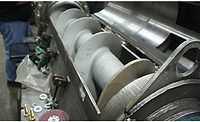
In these eco-conscious times, adhesives, sealants and coatings manufacturers are looking for ways to become more efficient and produce a smaller carbon footprint. A high-speed disperser is often used to disperse agglomerates into a liquid. If the agglomerates aren’t broken down to the desired size or grind, the product will be pumped over to a mill to finish off the process. This process has been the norm for many years; it takes time, but it works.
What if the product could be finished in the high-speed disperser, however, and not have to go to a mill to be completed? Even if only one or two batches could be produced by the high-speed disperser, manufacturers would save time and electricity by skipping the milling process for these batches.
A New Blade May Be the Answer
Using a new dispersion blade or a different style of blade can make the difference between long batch times and shorter, more efficient grind times. Several styles of blades are available to choose from, and not all batches require the same dispersion blade. When purchasing a new blade, ask questions about what style of blade should be used for your process. A different blade design might be more efficient and could possibly make a better product.Several guidelines can help determine the blade size required for a process: blades should be about one-third the diameter of the tank; standard dispersion blade tip speeds should be around 5,000 ft/min; and the disperser’s horsepower should be 1 HP per 10 gal of product. (These basic guidelines can be adjusted to your product line.)
A dispersion blade should be replaced before it becomes worn or damaged. A blade that is damaged will be out of balance and could cause premature wear of the bearings and belts. A worn-out blade also takes longer to make your batch, thereby requiring more electricity and labor time.
Best Practices
Check the teeth of a new impeller; the edges of a well-made dispersion blade look crisp, clean and squared off. These squared-off edges are designed to give the impeller the most efficient grind. Start a regimen of periodically checking the blade for signs of wear. As the blade begins to wear, the teeth start to round off. In time, the blade will eventually erode away until there are no teeth left. Such rounded corners decrease the effectiveness of the dispersion blade and precipitate the need for replacement.When installing a new impeller, run a standard batch of material and record the amps required to run the impeller. Check the amp draw of the machine in the same type of batch about once a week (or month, depending on the abrasiveness of your products). When a noticeable decrease in the amp draw for the same batch occurs, the impeller is losing its effectiveness and should be replaced.
Every batch of material has a specific recipe that includes a dispersion time. After installing a new impeller, check the batch several times during the dispersion phase and record how long it takes to bring the batch to spec. This recorded time is the guideline for how long it should take to make a batch properly. As the blade starts to wear, producing the desired results will take longer. The dispersion blade should be replaced when a proper dispersion can no longer be achieved in the expected amount of time.
Blade Optimization
Dispersion blades are a relatively inexpensive replacement item and should be changed on a regular basis. Inspect the blade often for worn or damaged teeth, analyze the amp draw of similar batches of material on a periodic schedule, and check to make sure that batches are produced in the right amount of time. If the teeth are worn or damaged, the amps have dropped, or it is taking longer to make batches to spec, it is time change the blade.For more information, contact Quickblades Inc. at (877) 618-8304, fax (260) 359-2066, e-mail sales@quickblades.net or visit www.quickblades.net.

